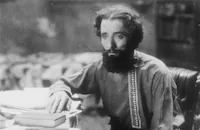Salome

Brief Synopsis
Cast & Crew
Charles Bryant
Nazimova
Rose Dione
Mitchell Lewis
Nigel De Brulier
Earl Schenck
Film Details
Technical Specs

Synopsis
Enraged by Jokaanan's refusal of her kiss, Salome dances for Herod in return for Jokaanan's head on a silver platter. Herod grants her request; but he is overcome with disgust at the sight of Salome kissing the head and has her killed.

Director
Charles Bryant
Cast

Nazimova
Rose Dione
Mitchell Lewis

Nigel De Brulier
Earl Schenck
Arthur Jasmine
Frederic Peters
Louis Dumar
Crew

Film Details
Technical Specs

Articles
Salome on DVD
Alla Nazimova (1879-1945) had wanted to stage Oscar Wilde's play all the way back to her days studying acting with Stanislavsky in Moscow. The czar's censors were just as determined that there would be no staging in Russia. Since its author's jailing for homosexual acts in 1895, Wilde's play was forbidden. Not until after the 1917 revolution did Salome have its inaugural Russian staging.
By then Nazimova had left Moscow for Broadway, then Hollywood, becoming a film star with the hit movie War Brides (1916) for Metro Studios. Not only did she star in her films, but she also wrote and directed them under assumed names. Her film's Art Nouveau sets were designed by her friend Natacha Rambova (formerly Winifred Shaughnessy of Salt Lake City) who married Nazimova's co-star in Camille (1921), Rudolph Valentino. With the money she made as a film star, Nazimova set off to make movies even more completely under her control, filming Ibsen's A Doll's House (1922) before finally tackling Salome, her dream project.
For decades rumors have swirled around this film; that Nazimova and Rambova were lovers and that Nazimova had insisted on an all-gay cast "in honor of Wilde." Biographers claim the rumors are doubtful but what was going on behind the camera mattered little compared to what was on the screen. A barely-dressed Nazimova as a pre-teen dancer entices not only her stepfather Herodias, but also everyone else at court, male and female. One exception is Herodias' male page who is clearly in love with the Captain of the Guard. The ladies of the court are men in drag.
This was noticed even at the time. Variety sniffed at "effeminacy" and the New York Censor's board deemed it "a story of depravity and immorality." As far as American moviegoers were concerned, the only sin of which Salome was guilty was being high art. The public stayed away, ending Nazimova's dreams of further productions.
Eighty years later, modern viewers will have their own problems with Salome. Despite costing $400,000 in 1923 dollars, the production never leaves the stage. The cast's acting, although quite in tune with the Symbolist style of Wilde's play, seems the essence of silent-movie overacting, especially Nazimova whose facial expressions conjure Sunset Boulevard's Norma Desmond at her most insane. The production, designed by Rambova vaguely after Aubrey Beardsley's drawings, is still eye-popping but Salome remains an often-static filmed play.
Accompanying the feature on the DVD is the 27-minute short film Lot In Sodom (1933). One of the first experimental films of the sound era, Lot In Sodom was shot by James Watson and Melville Weber using multi-superimpositions, filming in reflected surfaces and other techniques to provide an expressive if somewhat obscuring gloss to the Bible's most famous story concerning homosexuality. No activity is directly shown but the festival of leaping and dancing unclothed male figures provide enough shorthand information for inescapable conclusions. Intended for museum showings, Lot In Sodom bypassed the censors and was hailed by the cognoscenti.
Both films on the DVD have been restored by David Shepherd and Salome is here longer than any previous video release. Some nitrate damage appears near the beginning of the film, but it rarely distracts. Lot In Sodom comes from a somewhat worn print but has a very sharp image. Salome has two scores, a stereo one in avant-garde style from a French television broadcast and a more traditional score by the Silent Orchestra in Dolby 5.0 Surround.
For more information about Salome, visit Image Entertainment. To order Salome, go to TCM Shopping.
by Brian Cady

Salome on DVD
Quotes
Trivia
Notes
Natasha Rambova's sets and costumes were based on designs by Aubrey Beardsley. For information on other films featuring the historical character "Salome," please consult the entry for the 1918 Fox production Salome, directed by J. Gordon Edwards and starring Theda Bara (see AFI Catalog of Feature Films, 1911-20).

Miscellaneous Notes
Released in United States 1923
Released in United States June 7, 1989
Released in United States September 16, 1990
Shown at New York International Festival of Lesbian and Gay Film June 7, 1989.
Shown at New York Lesbian and Gay Experimental Film Festival, New York City September 16, 1990.
Selected in 2000 for inclusion in the Library of Congress' National Film Registry.
Released in United States 1923
Released in United States June 7, 1989 (Shown at New York International Festival of Lesbian and Gay Film June 7, 1989.)
Released in United States September 16, 1990 (Shown at New York Lesbian and Gay Experimental Film Festival, New York City September 16, 1990.)














